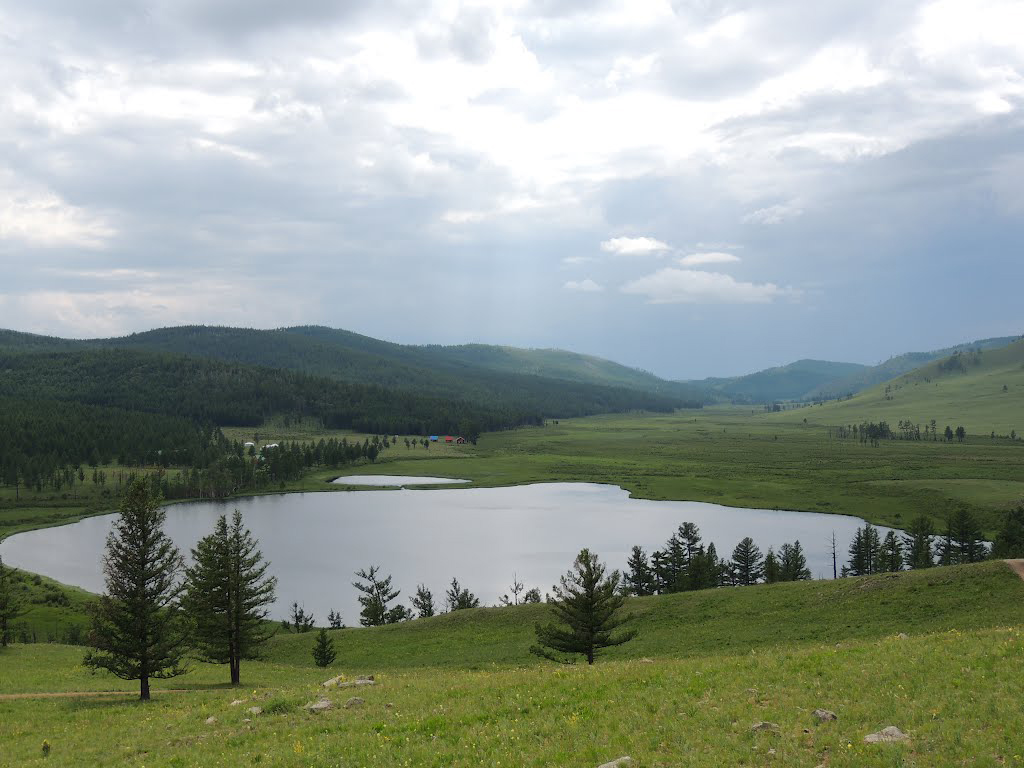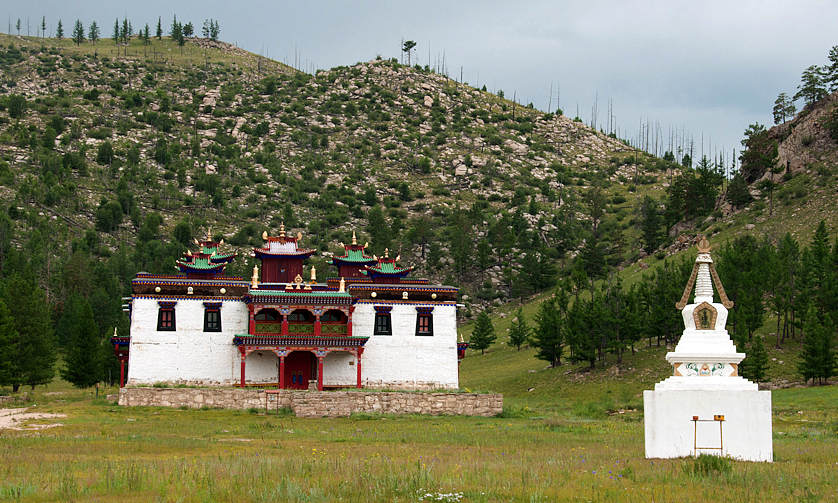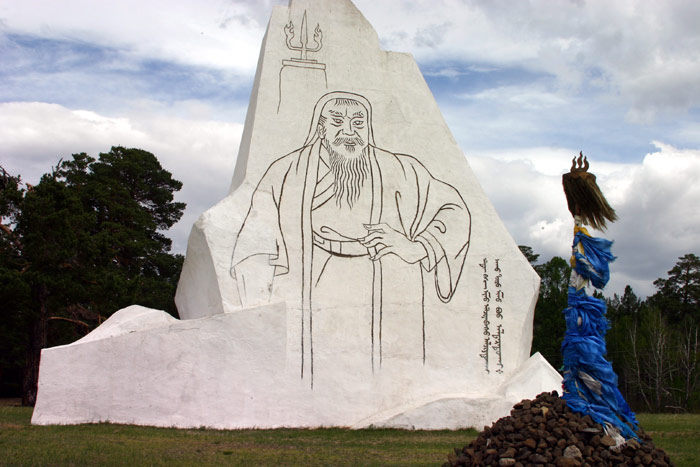
EASTERN MONGOLIA
Eastern Mongolia contains one of the largest – and last – undisturbed steppe ecosystems in the world, and is the core habitat of the Mongolian gazelle. There are meandering rivers, large wetland areas punctuated by beautiful lakes, swathes of multicolored wild flowers and huge herds of white-tailed gazelle. Besides the grasslands, the major feature of the region is the Khan Khentii Mountains, where was the birthplace of Genghis Khan.
Places to visit: Khan Khentii Mountain National Park, Onon Balj National Park, Oglogch Kherem, Deluun Boldog, Bereeven Monastery, Khukh Lake, Rashaan Khad.
Attractions: Hiking, horse riding, nomadic culture experiencing, sightseeing, camping in the wild, kayaking, fishing, bird watching, monastery visiting.
Khan Khentii Mountain National Park
This is the native land of Chinggis khan and contains many important historical and cultural sites. Khan Knentii Mountain NP was registered by UNESCO as a World Cultural Heritage Site in 1996 and located northeast of the capital city. Khan Khentii is covered with forests, taiga and mountain forest steppe. It is the land described in the Secret History of Mongols, a literary monument of the nation.
Onon Balj National Park
The Onon-Balj basin is located at the southern edge of Siberian boreal coniferous forest and stretched into Daurian steppe. Situated at the juncture of two big ecosystems of central Asia, the area is unique with its natural formation and rich in biodiversity. Yet, the ecosystem is very fragile. The forest and steppe landscape, its composition and specific ecological functions, also serves as a home to a number of rare and endangered species in Mongolia and the globally endangered birds such as white-naped crane, hooded crane and great bustard and a number of aquatic Asian species. In addition to its nature beauty and picturesque areas, the basin is abundant with historically and culturally important areas, particularly the historical sites related to Chinggis Khan, the Great Mongolian Emperor and other historical, cultural, scientific and ecological significant areas. The Onon-Balj was taken under the State protection in 2000 as a National Park, with 415,752 hectare area, to protect the biodiversity and its genetic bank and to develop environmentally friendly tourism based on natural and historical sites.
Khukh Nuur
 Khukh Nuur” in the Khar Zurkh Mountain is a beautiful place located in Khentii province. Besides being a beautiful nature, the place is unique due to the fact that the most important event of history of Mongolia took place here. At this very place, 800 years ago in 1189, Temujin came to the throne of Mongolia and was given the honorific title of “Chinggis Khan”, meaning supreme or great. Therefore this place is closely linked to the life of great Chinggis Khan. The great contribution of Chinggis Khan to unify all the Mongol aimags and establish an empire that streched from Black sea to the Pacific ocean and Siberia to Tibet started from this place. Probably because Chinggis Khan had chosen this place as the starting point, he succeeded to establish such a great empire. “Khukh Nuur” in the Khar Zurkh Mountain is a beautiful fresh water lake located at 1675 meters above sea level. The surrounding areas of the lake are forested Mountains which together form one of the most attractive places in Mongolia. The stone ruins of a ger with a diameter of 15 meters on the south side of this lake could be the ruins of the palace ger where Chinggis Khan was proclaimed khan. There are also wooden statues in the forest dedicated to Chingis Khan and the next 32 khans of Mongolia. The surrounding area of Khukh Nuur is quiet and peaceful place, wonderful for hiking&relaxation.
Khukh Nuur” in the Khar Zurkh Mountain is a beautiful place located in Khentii province. Besides being a beautiful nature, the place is unique due to the fact that the most important event of history of Mongolia took place here. At this very place, 800 years ago in 1189, Temujin came to the throne of Mongolia and was given the honorific title of “Chinggis Khan”, meaning supreme or great. Therefore this place is closely linked to the life of great Chinggis Khan. The great contribution of Chinggis Khan to unify all the Mongol aimags and establish an empire that streched from Black sea to the Pacific ocean and Siberia to Tibet started from this place. Probably because Chinggis Khan had chosen this place as the starting point, he succeeded to establish such a great empire. “Khukh Nuur” in the Khar Zurkh Mountain is a beautiful fresh water lake located at 1675 meters above sea level. The surrounding areas of the lake are forested Mountains which together form one of the most attractive places in Mongolia. The stone ruins of a ger with a diameter of 15 meters on the south side of this lake could be the ruins of the palace ger where Chinggis Khan was proclaimed khan. There are also wooden statues in the forest dedicated to Chingis Khan and the next 32 khans of Mongolia. The surrounding area of Khukh Nuur is quiet and peaceful place, wonderful for hiking&relaxation.
Oglogch Kherem-Ancestors Wall
Oglogch Kherem is one of the most important historical places in Mongolia which date back to the time of Chinggis Khan.
The wall is located at the base of Daichin Mountain, 8-10km from confluence of Ugluch and Bayangol rivers and 45km southwest from Batshireet village of Khentii province. Mongolia-American archaeological team identified at least 60 ancient graves within the walls, indicating that it may have been a royal cemetery. The wall is 2.5-3m high, 2.5m wide and approximately 3km long.
Bereeven Monastery
 Bereeven monastery was established in the 17 th century by order of Zanabazar, the first Buddist Saint of Mongolia, and is located in Omnodelger village of Khentii province. The monastery of Baldan Bereeven is surrounded by four mountains each said to resemble an animal: a lion on the east; a dragon on the south; a tiger on the west; and a Garuda on the north. Each cardinal point is also guarded by a Protector Deity. The originally temple was demolished during the persecutions of the late 1930s and the Red Jamsram painting damaged or destroyed. The Jamsran rock painting in the temple now is thought by some to be the original but no one is quite sure. At its peak it was one of the three largest monasteries in Mongolia and home to 1500 lamas. It was destroyed by thugs in the 1930s and by fire in the 1970s. Now only ruins remain. On the rock above a complex of small temples, now in ruins, is a Soyombo, the head symbol of the Soyombo Alphabet invented by Zanabazar. This Soyombo was reportedly painted by Lama Dampilranjamba in the late eighteenth century. According to legend Dampilranjamba said, "This Soyombo will remain here long after the rest of the monastery is destroyed and fallen into ruins.”
Bereeven monastery was established in the 17 th century by order of Zanabazar, the first Buddist Saint of Mongolia, and is located in Omnodelger village of Khentii province. The monastery of Baldan Bereeven is surrounded by four mountains each said to resemble an animal: a lion on the east; a dragon on the south; a tiger on the west; and a Garuda on the north. Each cardinal point is also guarded by a Protector Deity. The originally temple was demolished during the persecutions of the late 1930s and the Red Jamsram painting damaged or destroyed. The Jamsran rock painting in the temple now is thought by some to be the original but no one is quite sure. At its peak it was one of the three largest monasteries in Mongolia and home to 1500 lamas. It was destroyed by thugs in the 1930s and by fire in the 1970s. Now only ruins remain. On the rock above a complex of small temples, now in ruins, is a Soyombo, the head symbol of the Soyombo Alphabet invented by Zanabazar. This Soyombo was reportedly painted by Lama Dampilranjamba in the late eighteenth century. According to legend Dampilranjamba said, "This Soyombo will remain here long after the rest of the monastery is destroyed and fallen into ruins.”
Indeed most of the monastery was destroyed in the late 1930s but the Soyombo painting was not defaced.
Rashaan Khad
Rashaan Khad is one of the important historical heritages in Eastern Mongolia. The Rashaan Khad is situated in the territory of Batshireet village of Khentii province. According to archeological study, the complex belongs to the period between Stone Age and the 16th century. There are full of ancient rock carvings and paintings depicting animals, humans, as well as other tribal symbols in different scripts including Arabian-Persian, Mongolian, Tibetan, Chinese and others.
Deluun Boldog-Birthplace of Chinggis Khan
 For his 800th birthday, a statue of Genghis Khan was erected in 1962 at Deluun Boldog; a place believed to be the great khan's birthplace, close to what is today Dadal soum, an attractive wooded area in North-West Khentii region.
For his 800th birthday, a statue of Genghis Khan was erected in 1962 at Deluun Boldog; a place believed to be the great khan's birthplace, close to what is today Dadal soum, an attractive wooded area in North-West Khentii region.
The area contains trails and lakes for visitors as well as monuments where you can learn why this fierce warrior and great leader is still revered today.Dadal Sum once housed one of three great lamaist temples consecrated to Chinggis Khan, but which was razed in the 1930s. Now there are stone monuments to him erected in the surrounding beauty of the Mongolian countryside. Also there is Burkhan Khaldun Mountain, which is mountain itself and/or its proximity areas are rumored to be the birthplace of Chinggis Khan, as well as the purported location of his tomb. The Burkhan Khaldun is one of the most sacred mountains in Mongolia.
The mountain is located in the 12,000 km² Khan Khentii Strictly Protected Area established in 1992. It is considered the most sacred mountain in Mongolia, because it was first designated as sacred by Chinggis Khan, although it previously had had strong religious significance prior to Chinggis Khan making it such a powerful landmark. This mountain is noted in Mongolian secret history which is historical note at Chinggis Khan’s rule time.
Recommended


Mongolian winter is the most incredible winter that one might experience and there is plenty to see and enjoy during a winter travel. Glittering white snow, clear fresh air, sun, and little chills are the image of Mongolian winter. Taking this fan...
Duration: 3 Days / 2 Nights
Destination: Gobi - Central


All of Mongolians celebrate the Lunar New Year, which is called in Mongolia “Tsagaan Sar” or the “White Moon”. It is widely celebrated throughout the country around January or February according to the combination of Solar-...





